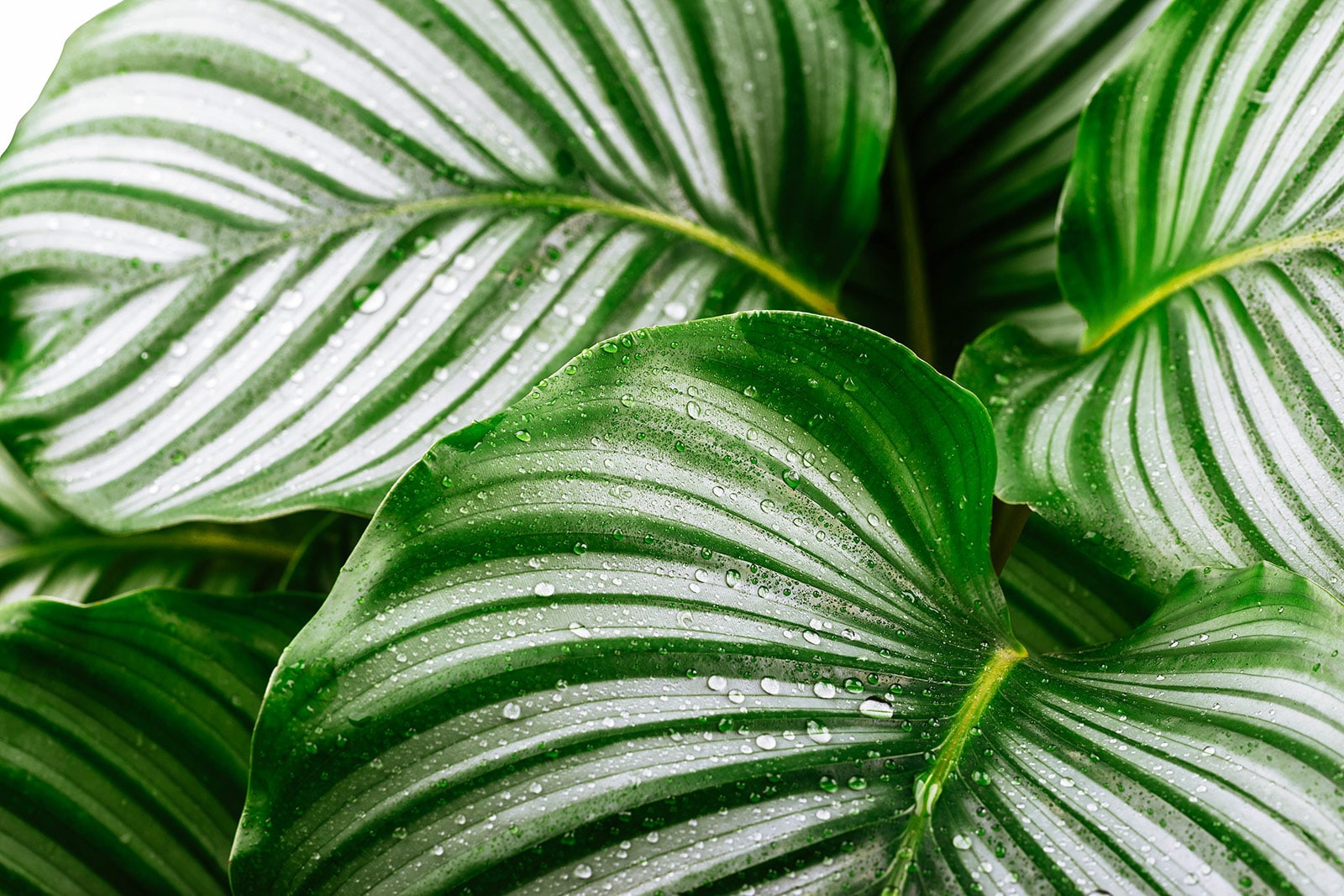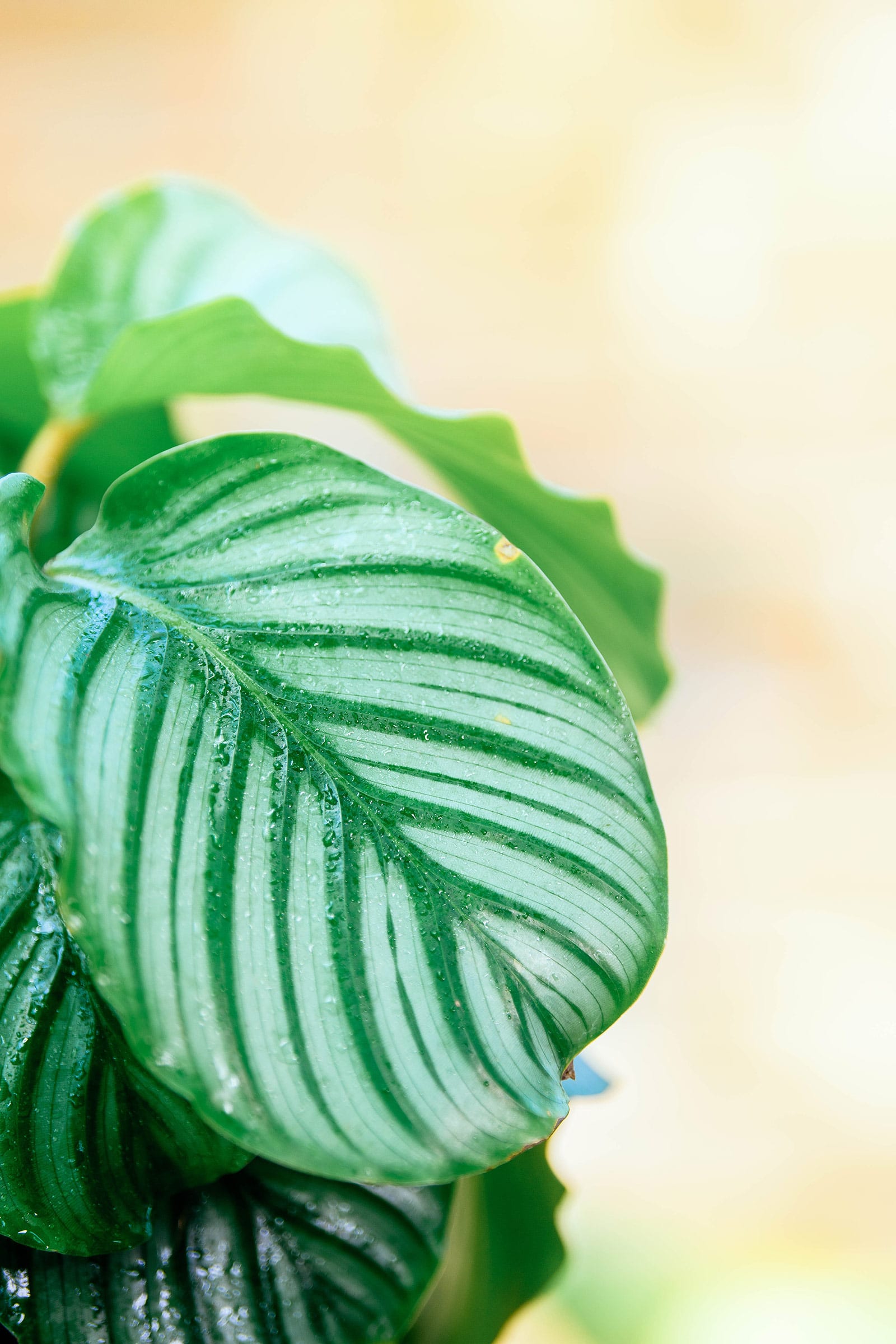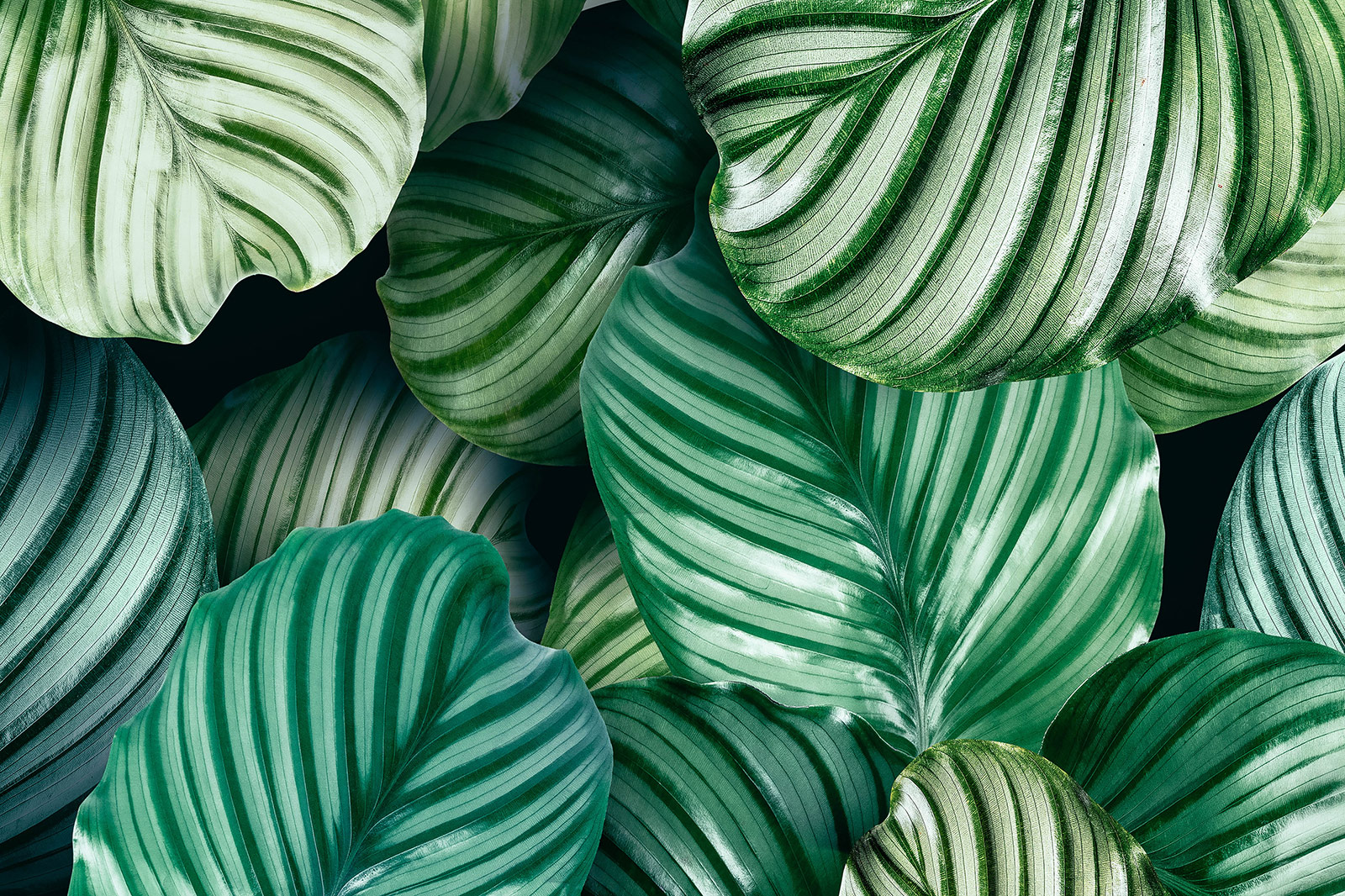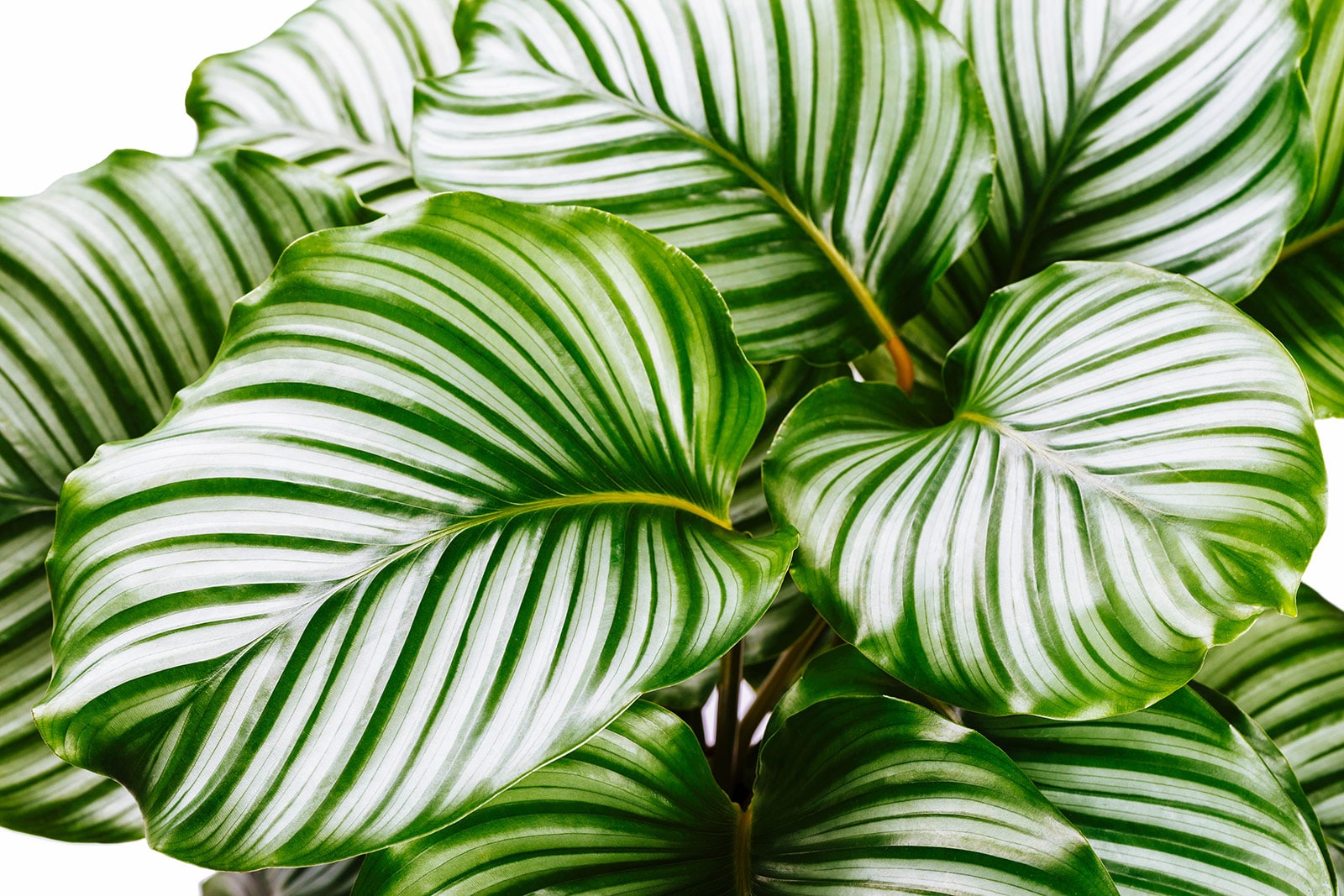Calathea orbifolia, also known as the orbifolia prayer plant, is a type of prayer plant that is popular for its large and striking green-striped leaves.
This prayer plant species is native to Bolivia, and thus enjoys humid and tropical climates that mimic the rainforests of South America. Despite its love of humidity, it’s fairly easy to maintain the plant’s requirements in your own home—which is partly why it’s such a beloved houseplant.
If you’re new to the plant world or looking to add another member to your indoor jungle, here is the ultimate Calathea orbifolia care and growing guide!
| Common name(s) | Prayer plant, orbifolia prayer plant |
| Scientific name | Calathea orbifolia |
| Family | Marantaceae |
| Height and spread | Up to 3 feet tall and 2 feet wide |
| Light | Bright indirect light |
| Soil type | Well-draining and slightly acidic |
| Water | Keep lightly moist |
Disclosure: If you shop from my article or make a purchase through one of my links, I may receive commissions on some of the products I recommend.

About Calathea orbifolia
A Calathea orbifolia plant is a beautiful and exotic choice, especially if you love the jungle vibes of other tropical plants (like Alocasia ‘Polly’ and other Alocasia varieties) or prayer plants in general (like Maranta, Ctenanthe, and Stromanthe, whose leaves also fold up at night).
The name of the plant is somewhat confusing though, as many species in the genus Calathea were reclassified in the late 20th century. Calathea orbifolia is now classified as Goeppertia orbifolia, though the original classification is still the most common name for the plant and what you’ll find it labeled as in most nurseries and plant shops.
As an aside, the confusing name change—which still hasn’t caught on with houseplant enthusiasts—also happened to other Calatheas, including the popular Calathea makoyana and Calathea ornata (which are now part of Goeppertia, but nearly everyone continues to call them Calathea).
Calathea orbifolia grows up to 3 feet tall and 2 feet wide with each leaf growing up to 12 inches wide, making this one of the largest prayer plant species. The growth rate is moderate, and the plant will go through a period of dormancy in winter.
Orbifolia prayer plants are known for their striking leaves: oval-shaped and broad, exhibiting a predominantly green base with light green or silvery streaks. These streaks mimic the same patterns as a candy cane, making them look particularly unique.
Where to buy Calathea orbifolia plants:

Caring for Calathea orbifolia
The orbifolia prayer plant has moderate maintenance requirements, though it’s sometimes known for being a diva in the plant world because its requirements (particularly for temperature and humidity) are so specific. However, this guide aims to cut through the confusion of caring for your Calathea orbifolia and make it a suitable houseplant for both beginners and advanced plant hobbyists alike.
Light and temperature
Because Calathea orbifolia is part of the forest undergrowth in its natural habitat, it prefers these types of soft light conditions in your home as well. The plant prefers to be in a bright room without exposure to direct sunlight, so it’ll happily live in a kitchen, bathroom, or bedroom where it gets indirect light and isn’t too close to a window. Direct sunlight is too harsh on the plant (potentially scorching the leaves) and can dehydrate it too quickly.
Temperature-wise, most homes that keep a comfortable and consistent ambient room temperature will have no trouble keeping their plant happy.
Calathea orbifolia likes temperatures between 65°F and 75°F. It’ll let you know if it isn’t enjoying the temperature in your home, however. If the leaves begin to droop, this means the temperature is too cold. If the leaves start to curl, this means the temperature is too warm.
Try to keep your Calathea orbifolia away from drafts, A/C units, radiators, heating vents, and fireplaces. The plants doesn’t do well with sudden changes in temperature, as it can lead to leaf discoloration, leaf loss, and other signs of stress.
Water and humidity
Calathea orbifolia likes to remain moist but not soggy, and it copes better with less water than too much water.
In general, I recommend watering your orbifolia prayer plant once a week depending on its moisture level. The best way to check whether your Calathea orbifolia needs to be watered is by sticking your finger about an inch down into the soil. If the soil feels dry, give it some water, but make sure the water drains freely out the bottom of the pot before giving more water.
While you’ll probably end up watering your Calathea orbifolia once a week in summer, the watering time can be reduced to once every two to three weeks in the colder months while the plant is dormant.
Calathea orbifolia is native to the tropical rainforests of Bolivia, so its humidity requirements are rather high but typical for this type of plant. It thrives in high-humidity areas of 50 to 60 percent at minimum. Unfortunately, the average humidity in a house is typically below 50 percent, which isn’t suitable for the prayer plant.
To maintain proper humidity, I recommend running a room humidifier nearby, keeping your plant in the bathroom where it benefits from the naturally warm and humid environment, or lightly misting your Calathea orbifolia every day. Not only will this help mimic the humidity in a rainforest, but misting the leaves will help them stay shiny and clean from dust.
If you have other similar houseplants, you can group them together to create a more humid microclimate in your home. This is a fantastic way to show off all your other jungle plants or prayer plants while keeping things a little lower-maintenance for you.
Soil and planting
As with most tropical houseplants, Calathea orbifolia requires well-draining soil that stays moist but not too wet. The ideal soil pH is around 6.5, which can be achieved by creating (or buying) your own peat-based potting soil.
I like to combine equal parts of potting mix, a moisture-retaining element (like peat moss, sphagnum moss, or coco coir), and a drainage-promoting element (like perlite, pumice, or orchid bark) to help my plant thrive.
Make sure you use a pot with drainage holes in the bottom, and try to avoid terra cotta pots (unless you’re prone to overwatering). Terra cotta is a porous material and tends to dry out the soil too quickly.
Recommended products for Calathea orbifolia care:
- FoxFarm Ocean Forest Potting Soil
- Better-Gro Special Orchid Potting Mix
- Better-Gro Orchid Moss
- Perfect Plants Organic Perlite
- Nature’s Footprint Pumice Soil Amendment
- ThermoPro Digital Hygrometer
Fertilizing
Calathea orbifolias aren’t the hungriest of plants, so unless you’re wanting very fast growth, you don’t have to worry too much about fertilizing. The best time to fertilize an orbifolia prayer plant is during the growth season, which is typically between spring and summer.
You can feed your plant once a month with a liquid houseplant fertilizer with low potassium levels and high nitrogen levels, as this will improve the size and color of the vivid leaves.
There’s no need to feed your Calathea orbifolia during winter, as this is when the plant goes into its dormant state. Doing so can burn the its roots, ultimately resulting in the death of the plant.
Likewise, don’t fertilize when the plant is doing poorly—try to troubleshoot the root of the problem (watering, light, or humidity) and nurse it back to health first. (I’ll talk more about common Calathea orbifolia problems below and what you can do about them.) Basically, if you’re in doubt about when to fertilize your Calathea orbifolia—don’t. Overfertilizing is a common and hard-to-fix problem with all houseplants.
Recommended fertilizers for Calathea orbifolia:
- Houseplant Resource Center Liquid Fertilizer for Houseplants
- Instant Biologics Instant Plant Food (Fizzing Nutrient Tablets)
- Maxsea All-Purpose Seaweed Plant Food
Pruning
A calathea orbifolia doesn’t require much pruning throughout the year unless necessary. Extra leaves or aerial shoots can be cut off with a sharp knife or a pair of scissors if the plant is looking too bushy, but this comes down to personal preference.
You should definitely remove damaged, dry, or yellow leaves, as this will stop the plant from unnecessarily wasting nutrients on parts of the plant that cannot be saved. However, avoid pruning your Calathea orbifolia during fall and winter. This is when the plant is about to enter (or is in) its dormant period, which means it needs all of its nutrients to emerge from this stage.
Dividing or repotting
Calathea orbifolia is one of the largest prayer plant species, making it a prime candidate for division when its size becomes too much for the space you’ve given it. In early spring to early summer, simply remove the offshoots (I’ll cover how to do that in the next section on propagation) and pot them up separately; that way, the mother plant can stay in her original pot.
Otherwise, you can repot your Calathea orbifolia when the roots start to protrude from the bottom of the drainage holes. Find a larger pot (just one size up—it doesn’t like being in a pot that’s too large) and fill it with fresh, well-draining soil. I recommend repotting your plant once every two years or so depending on its growth. If you choose not to repot your plant, you should give it fresh potting soil at the same two-year interval to keep it healthy.
You might notice that your Calathea orbifolia appears unhappy after it’s repotted, but this is normal. Just continue giving it the right amount of water (not too much and not too little) and it should start to perk back up in a few days. In some cases, the plant might not produce any new growth for a couple of months, but if it otherwise looks healthy, leave it be.

Propagating Calathea orbifolia
Calathea orbifolia is notoriously tricky to propagate since it’s sensitive to repotting and root disturbance. Because of this, I recommend propagating an orbifolia prayer plant in spring (the start of its growth period) and doing it at the same time you’re repotting to minimize stress on the plant. This way, it still has the whole season to recover.
While you can technically propagate a Calathea orbifolia through stem cuttings, this method is largely unsuccessful.
Instead, rhizome division is the best way to propagate this plant species, and it’s nearly fail-proof. Here’s how to do it:
- Lift the plant out of the pot and carefully shake excess soil off the roots to expose the rhizome.
- Take a moment to check the roots to make sure they’re all healthy. Any brown, black, or soft roots are a sign of rot and should be trimmed.
- Using a sharp blade, cut off a section of rhizome that has leaves and roots attached.
- Plant the rhizome in a new container filled with fresh, well-draining potting soil. Keep the container in bright, indirect light, and make sure the soil is moist, but not soaked. It will take about a month for the new plant to become established.

Troubleshooting Calathea orbifolia problems
As with any houseplant, Calathea orbifolia is susceptible to some common problems that, in most cases, can be treated with preventative measures.
Root rot
Undoubtedly the most serious problem of all, root rot is an unfortunately common problem in Calathea orbifolia. Root rot is a disease that occurs when the plant has been overwatered, which essentially drowns the roots and kills them off. Without treatment, the rot can spread amongst the roots and into the plant itself. This means that in a lot of cases, root rot is incurable.
The best way to cure root rot is to make sure you’re not overwatering your plant. While Calathea orbifolia prefers a moist environment, it will fare better in slightly dry and underwatered soil than waterlogged soil.
Always do the “finger test” (or use a moisture meter like this one) to check that the first inch of soil is completely dry before watering the plant. Look for excess water freely draining out the bottom of the pot before watering again.
It’s not always easy to tell if your plant is suffering from root rot until it’s almost too late. The best way to check for root rot is when you repot the plant, as this will allow you to view the roots without all that soil in the way.
If you see rotted roots (which are brown and mushy), you can remove them by cutting them off with a knife or scissors. You should also repot the plant in fresh potting soil that’s amended with perlite, pumice, or orchid bark to help with drainage.
Clogged pores
Due to the large size of the leaves, Calathea orbifolia is prone to developing clogged pores as a result of collecting dust.
Not only does dust make the plant look dull, it can clog the pores and prevent the plant from efficiently gathering enough sunlight. While this won’t affect the overall health of your plant, I recommend wiping the leaves about once a month with a clean, slightly damp cloth on both sides.
Pests
Calathea orbifolia plants are commonly infected with pests such as spider mites and aphids, which suck on the sap from the leaves. Without treatment, these pests can create discoloration or even holes in the plant, affecting its overall health.
The best way to get rid of aphids and spider mites is to spray them with insecticidal soap, which you can easily make at home. Make sure to test just one leaf first before applying insecticidal soap to the whole plant.
Discolored leaves
Calathea orbifolia plants are notorious for showing you if they’re thriving or not through their leaves. Unfortunately, this means the leaves are prone to developing discoloration or changing in shape in response to stress.
In most cases, when the leaves are starting to turn brown and crispy, or if they’re starting to curl, this means the plant has been underwatered or is in direct sunlight. Sometimes, if you notice this problem early enough, you can fix it by moving the plant elsewhere and giving it more water.
On the other hand, if the leaves turn yellow and droopy, this is a sign of overwatering or waterlogged soil. Other symptoms will usually accompany this, including stunted growth and the appearance of rotted roots.
If your plant is getting quite old and the leaves are turning brown, this is totally normal and unavoidable. This happens as a result of extensive photosynthesis, which is indicative of getting older.
Transplant shock
This is a fairly common issue in Calathea orbifolia plants. Since these prayer plants are so sensitive to even the slightest changes in their environment, they can go into a dormant shock after being transplanted into a new pot.
It doesn’t matter whether they need to be repotted due to outgrowing their previous pot or if they have root rot—it has to be done. Just be prepared for your plant to be a bit dramatic about it.
My advice is to try to make the transplant as smooth as possible by mimicking the exact soil mixture in the new pot, and making sure to water the plant immediately after repotting it. Also, don’t move the new pot into another position in your house! If your plant has been thriving in its current position, don’t try to fix what isn’t broken.

Common questions about Calathea orbifolia care
Is Calathea orbifolia hard to care for?
Calathea orbifolia plants aren’t the hardest houseplants to care for, but they also aren’t the easiest. The only specific musts for these plants are indirect light, warm temperatures, and humidity, as well as the standard soil and watering requirements.
Since orbifolia prayer plants tend to communicate any problems through physical signs such as leaf discoloration, it’s quite easy to tell when they’re happy or not.
How often do you water Calathea orbifolia?
Depending on the soil composition and other factors like sunlight, temperature, and humidity, you should water a Calathea orbifolia once every one to two weeks. The plant should only be watered when the first inch of soil is completely dry, which you can discern by sticking your finger into the soil.
Orbifolia prayer plants require less watering during winter, as this is their dormancy period.
Is Calathea orbifolia toxic to cats and dogs?
Calathea orbifolia is an animal-friendly plant, as it’s safe for both cats and dogs. So, don’t be afraid to display these plants all around your home!















